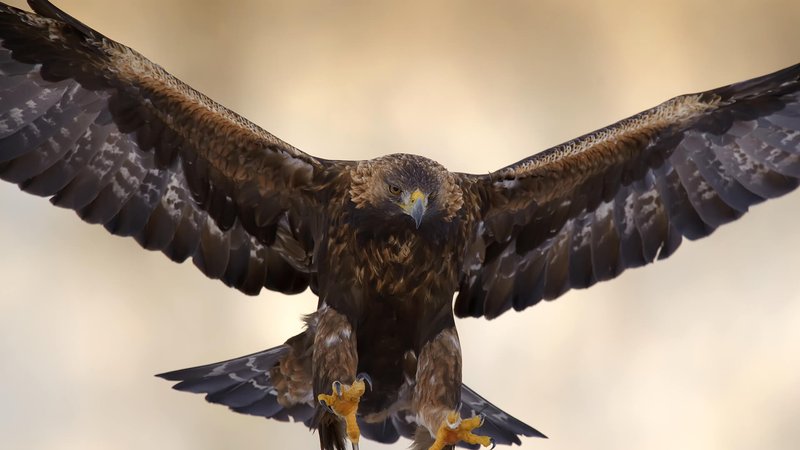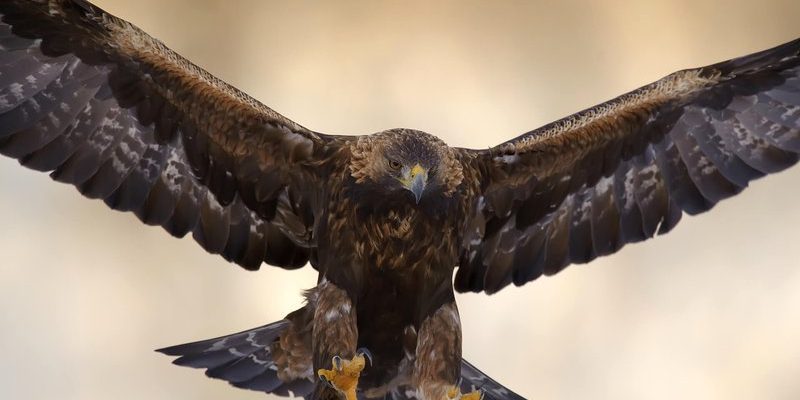
Imagine you’re outside on a crisp, clear day, and you spot a golden eagle circling overhead. It glides effortlessly on the wind, scanning the ground for its next meal. This remarkable ability to combine speed, agility, and keen eyesight sets the golden eagle apart from many other birds of prey. It’s fascinating to think that these birds have evolved over thousands of years to perfect their hunting techniques—almost like a well-rehearsed play, where every move counts.
In this article, we’ll dive deep into the extraordinary flying and hunting techniques of the golden eagle. We’ll uncover how they soar through the skies, what makes their hunting methods so effective, and the adaptations that allow them to thrive in their environments.
The Art of Soaring: How Golden Eagles Fly
Golden eagles are masters of soaring. Their large wings can span up to 7.5 feet, and they know how to take advantage of thermal updrafts—rising columns of warm air that carry them higher into the sky. Imagine being able to ride invisible currents, allowing you to glide effortlessly without flapping your wings. This technique is both energy-efficient and effective for spotting prey from above.
When soaring, golden eagles can reach impressive speeds of up to 30 miles per hour without using much energy at all. Here’s the thing: they often prefer to stay high in the sky, where their sharp eyesight allows them to spot small animals like rabbits or rodents from incredible distances. It’s like having a superpower—seeing your next meal from almost a mile away!
But soaring isn’t just about getting high; it’s also about playing the wind. Golden eagles can maneuver through the air with precision, diving steeply to catch their prey or quickly changing direction to dodge obstacles. This incredible control makes them not just aerial acrobats but also highly efficient hunters.
Eyes to the Skies: Exceptional Vision
One of the most fascinating aspects of a golden eagle is its eyesight. Their vision is estimated to be four to eight times better than that of humans. What does that mean? Well, they can see small animals from great distances, even when they’re moving!
Let me explain: golden eagles have large eyes packed with light-sensitive cells, which allow them to see ultraviolet light. This ability helps them detect the urine trails of small mammals, leading them to potential meals. You might be wondering how this works—imagine having a built-in GPS for spotting your favorite snacks, even when they’re hidden from view.
Not only can they see well, but they can also focus quickly on moving objects. When a golden eagle spots prey, it zeroes in fast. This sharp focus complements their ability to fly at high speeds, allowing them to swoop down and capture their meals with astonishing accuracy.
Hunting Strategies: A Combination of Speed and Stealth
When it comes to hunting, golden eagles are anything but ordinary. They employ a variety of strategies to catch their prey, including ambush and stoop diving. Picture this: an eagle perches silently on a tree branch, scanning the ground below for the slightest movement. This ambush technique allows them to blend into their surroundings while waiting for the perfect moment to strike.
Once they spot their target, they’ll often launch themselves into a powerful stoop dive. This is where they really showcase their speed—golden eagles can reach speeds of over 150 miles per hour during a dive! That’s faster than most cars on the highway. If you can imagine the adrenaline of taking a sudden plunge from above, that’s what it feels like for the eagle as it darts towards its unsuspecting prey.
Once in close range, their powerful talons are the final touch. These adaptations are designed to grip and hold onto their prey tightly. A golden eagle’s grip is incredibly strong, making it difficult for even the liveliest of animals to escape once caught.
Adaptations for Success: Beaks, Talons, and More
Golden eagles have unique adaptations that enhance their hunting prowess. Their beaks are hooked and sharp, perfect for tearing into flesh. This adaptation is essential for quickly consuming their catch, ensuring they get the energy needed for their next flight.
Furthermore, their talons are massive—perfect for gripping and holding onto their prey. Imagine having claws that can crush bone; that’s the strength these birds boast. They’re designed not just for grabbing but also for striking. The speed and force with which a golden eagle can strike are incredible; they can break the spine of small mammals with a single blow.
Additionally, the golden eagle’s plumage plays an essential role in its hunting success. Their feathers are not only beautiful but also serve to streamline their body during flight, reducing drag and allowing for smoother, faster movements. In the world of hunting, every little detail counts, and these adaptations give the golden eagle a competitive edge.
The Role of Territory in Hunting Success
Territory is important for golden eagles. They’re known for being quite territorial, often defending large areas to ensure they have enough food. A typical golden eagle’s territory can cover up to 60 square miles, depending on the availability of prey.
By maintaining a well-defined territory, golden eagles reduce competition for food. They can focus their hunting efforts on familiar grounds where they know the best spots to find food. Think of it as having your favorite restaurants in a particular neighborhood—you know where to go for a good meal!
If another eagle intrudes on their space, they’re not afraid to put on a show. They’ll engage in impressive aerial displays, showcasing their strength and agility, which can deter other birds from entering their territory. This behavior helps them not only protect their hunting grounds but also ensures they can feed themselves and their young.
The Importance of Adaptability
One of the most notable traits of the golden eagle is its adaptability. They can thrive in a variety of habitats, from rugged mountains to grasslands and even deserts. This flexibility is key to their success as a species. If one food source becomes scarce, they can easily shift their diet to include different animals.
This adaptability also extends to their hunting techniques. While they primarily hunt small mammals, they can switch to birds or even reptiles when necessary. It’s like having a diverse menu; it keeps things interesting and ensures they aren’t dependent on just one type of food.
Furthermore, environmental changes force these eagles to adjust their hunting strategies and locations. With changing climates and human encroachment, they’ve shown resilience by finding new territories that allow them to continue thriving.
The golden eagle is a symbol of power and elegance, a true master of the skies. Its unique flying and hunting techniques allow it to be one of nature’s most efficient predators. With their incredible vision, swift aerial maneuvers, and powerful adaptations, they remind us of the beauty and complexity of the natural world.
As we continue to learn about these amazing birds, it’s crucial to understand their role in the ecosystem and the importance of conserving their habitats. By protecting golden eagles and their territory, we help preserve the delicate balance in nature. Every time we spot one soaring overhead, we’re witnessing a remarkable story of evolution, skill, and survival.

